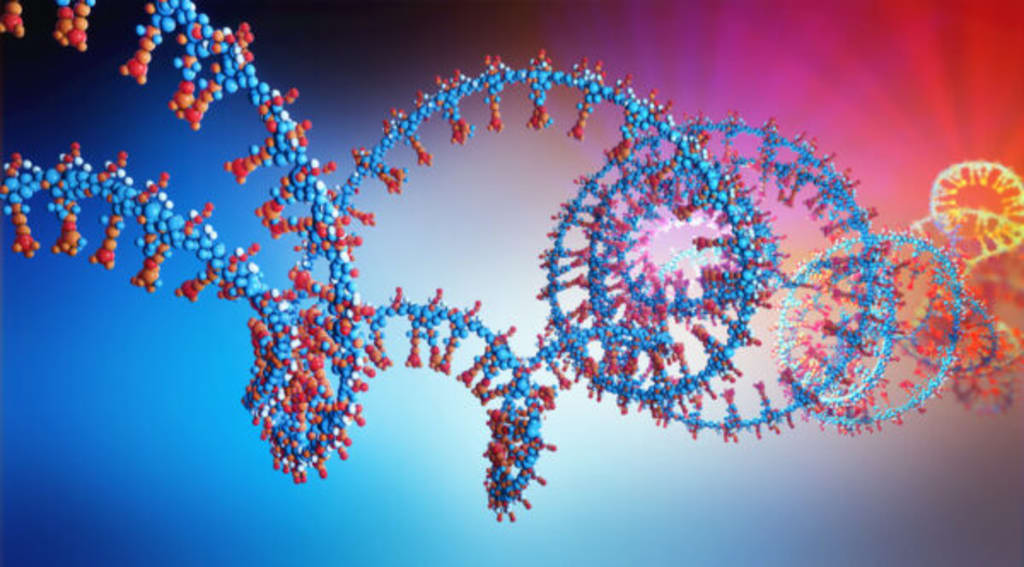DNA and RNA are two fundamental molecules essential
DNA and RNA are indispensable molecules

DNA (deoxyribonucleic acid) and RNA (ribonucleic acid) are two fundamental molecules essential to all known forms of life. Both play crucial roles in genetics, but they have distinct structures, functions, and properties. This comparison explores their differences and similarities in detail.
**Structure:**
1. **Composition and Nucleotides:**
- **DNA:** DNA is composed of long chains of nucleotides, each consisting of a deoxyribose sugar, a phosphate group, and a nitrogenous base. There are four nitrogenous bases in DNA: adenine (A), thymine (T), cytosine (C), and guanine (G). These bases pair specifically (A with T and C with G) through hydrogen bonds to form the double helix structure.
- **RNA:** RNA is also composed of nucleotides, but its sugar is ribose instead of deoxyribose. The nitrogenous bases in RNA are adenine (A), uracil (U), cytosine (C), and guanine (G). Unlike DNA, RNA is typically single-stranded and does not form a double helix.
2. **Double vs. Single-Stranded:**
- **DNA:** DNA is usually found as a double-stranded helix with complementary strands running in opposite directions (antiparallel). This structure is stable and allows DNA to store genetic information securely.
- **RNA:** RNA is generally single-stranded, which allows it to fold into various shapes necessary for its diverse functions. Some RNA molecules can form secondary structures by folding back on themselves, creating regions of double-stranded RNA.
**Function:**
1. **Genetic Information Storage:**
- **DNA:** The primary function of DNA is to store and transmit genetic information. It serves as the blueprint for all cellular functions and the development of organisms. DNA contains the instructions needed for the synthesis of proteins and guides the cell's activities and division through replication.
- **RNA:** RNA plays several roles in the expression of genetic information. It acts as a messenger (mRNA) that carries instructions from DNA to the ribosomes, where proteins are synthesized. Additionally, RNA molecules such as ribosomal RNA (rRNA) and transfer RNA (tRNA) are critical in the protein synthesis process. RNA can also have catalytic and regulatory roles (e.g., ribozymes and microRNAs).
2. **Stability and Longevity:**
- **DNA:** DNA is highly stable due to its double-stranded structure and the presence of deoxyribose sugar, which is less reactive than ribose. This stability is essential for the long-term storage of genetic information. DNA can persist for the life of the cell and, in many cases, for many generations.
- **RNA:** RNA is more prone to degradation due to the presence of the hydroxyl group on the ribose sugar, making it more chemically reactive and less stable than DNA. RNA molecules are typically short-lived, with lifespans ranging from minutes to hours, ensuring that they are produced and degraded as needed by the cell.
**Synthesis and Processing:**
1. **Replication:**
- **DNA:** DNA replication is a highly regulated process that ensures each daughter cell receives an accurate copy of the genetic material. Enzymes like DNA polymerases are responsible for synthesizing new DNA strands using the original strands as templates.
- **RNA:** RNA is synthesized from DNA through a process called transcription, where RNA polymerase creates an RNA copy of a DNA template. This process does not require a primer and involves the complementary pairing of RNA nucleotides with the DNA template.
2. **Post-Transcriptional Modifications:**
- **DNA:** DNA does not undergo significant post-synthetic modifications, but it can be methylated, which affects gene expression.
- **RNA:** After transcription, RNA molecules often undergo several modifications, including splicing (removal of introns), 5’ capping, and 3’ polyadenylation in eukaryotes. These modifications are crucial for the stability, localization, and translation of the mRNA.
**Variations and Types:**
1. **DNA:**
- **Genomic DNA:** The main form of DNA found in the chromosomes of the nucleus (in eukaryotes) or nucleoid region (in prokaryotes), containing the organism's entire set of genes.
- **Mitochondrial DNA (mtDNA):** A small circular DNA molecule found in mitochondria, which is maternally inherited and encodes genes essential for mitochondrial function.
2. **RNA:**
- **Messenger RNA (mRNA):** Carries genetic information from DNA to the ribosomes for protein synthesis.
- **Ribosomal RNA (rRNA):** A structural and functional component of ribosomes, facilitating protein synthesis.
- **Transfer RNA (tRNA):** Delivers the appropriate amino acids to the ribosome during protein synthesis.
- **Non-coding RNAs (ncRNAs):** Includes various types of RNAs that do not code for proteins but have regulatory, structural, or catalytic roles (e.g., microRNA, small interfering RNA, long non-coding RNA).
**Conclusion:**
DNA and RNA are indispensable molecules with unique and complementary roles in the cell. DNA’s stability and structure make it the ideal molecule for storing genetic information, while RNA’s versatility allows it to execute and regulate the expression of that information. Understanding the distinctions and interactions between DNA and RNA is fundamental to molecular biology, genetics, and biotechnology, impacting areas from medical research to evolutionary studies.
About the Creator
Enjoyed the story? Support the Creator.
Subscribe for free to receive all their stories in your feed.






Comments (1)
Well done on ti Mithun!